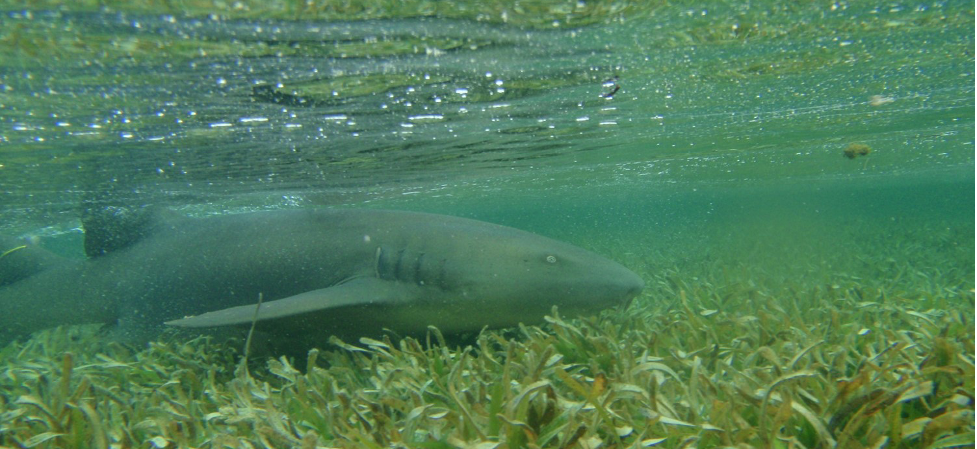The vulnerable site, used repeatedly by the same sharks for decades, may have been permanently altered by direct hit from the storm

BOSTON, MASS. (Oct. 18, 2022) – Research conducted by the New England Aquarium is highlighting the importance of protecting a critical habitat for sharks and rays after the area took a direct hit from Hurricane Ian.
The research, published in the journal PLOS ONE, is the longest running study of shark mating behavior in the world, and found individual nurse sharks returning to the Dry Tortugas, Florida, mating site repeatedly for up to 28 years.
“When we started observing sharks at this site in the early 1990s, we could’ve never guessed that some of those same animals would still be mating here into the 2020s,” said Harold “Wes” Pratt, Adjunct Scientist in the New England Aquarium’s Anderson Cabot Center for Ocean Life and lead author of the study.
Before the current study, nurse sharks were only thought to live for about 24 years, but this work expands the known life span well into their 40s and possibly older.
“The longevity of these animals and the fact that sharks were first seen mating here in the 1800s suggest that this area is very important to their life cycle,” said Dr. Nick Whitney, a Senior Scientist at the New England Aquarium and co-author of the study. “That’s why we’re concerned about the impact of the hurricane on these sharks and this site.”
Hurricane Ian passed directly over the Dry Tortugas on the night of September 27, 2022, marking the storm’s first U.S. landfall and bringing winds and waves that severely altered the small islands that protect the shallow water mating grounds. So far, the scientists have been unable to confirm whether their underwater monitoring stations survived the storm, or whether the sharks have returned to the area again since the storm passed.
“We have many years of data from acoustic receivers that listen for our tagged sharks 24/7 all year round,” said Dr. Ryan Knotek, Associate Scientist with the Aquarium and co-author of the study. “Data from those receivers show that September and October are important months when females come into the shallows preparing to give birth, like a shark maternity ward.”
The data also revealed the first known example of individual female sharks switching their reproductive cycle. While male nurse sharks arrived annually in May and June, females arrived every two and sometimes three years in June. Females showed a three-year cycle in 32% of cases, which would reduce the lifetime reproductive output of a female nurse shark by 11% compared to what would be expected from a strict biennial cycle, a finding that could have broad management implications.
Whether female sharks will be able to use the area this fall is one question, but another is whether the altered site will continue serving its function as a courtship and mating ground next summer. “We have seen changes to the study site over the years from shifting sands caused by waves and storms, but this direct hit from Hurricane Ian appears to have altered the landscape dramatically,” said Pratt. “We don’t know if it will still have the perfect combination of shallow, warm, still water with sandy bottom that seems to make it appealing to the sharks.”
The science team is currently seeking funding to return to the site in 2023 to measure the true impact of the storm on the shark population.
Housed within the Aquarium’s Anderson Cabot Center for Ocean Life, scientists in the Fisheries Science and Emerging Technologies (FSET) Program use cutting-edge technology to investigate critical fisheries issues, providing scientific data to fisheries managers and conservation leaders on the ocean’s most ecologically- and economically-important species. The program’s electronic tagging technologies—including acoustic and satellite telemetry—give scientists valuable insight into the lives of marine species and complex issues facing our ocean. In addition to shark species, scientists have active research underway on sea turtles, rays, and skates.
Additional resources: Link to available images; Link to NW blog post about the study.
###
The New England Aquarium is a global leader in marine science and conservation, working to safeguard ocean animals and habitats. With more than one million visitors a year, the Aquarium is one of the premier visitor attractions in Boston and a major public education resource for the region. The Aquarium’s research and rescue efforts build on the institution’s 50-year legacy of protecting the blue planet and advocating for a vital and vibrant ocean. In the Anderson Cabot Center for Ocean Life, scientists conduct applied marine research that informs ocean management, policy, and industry practices, and contributes to the innovation of new technologies. Through its Sea Turtle Rescue Program, the Aquarium helps protect critically endangered and threatened sea turtle populations through rescue, rehabilitation, and release efforts.
MEDIA CONTACT:
Pam Bechtold Snyder – psnyder@neaq.org, 617-686-5068
